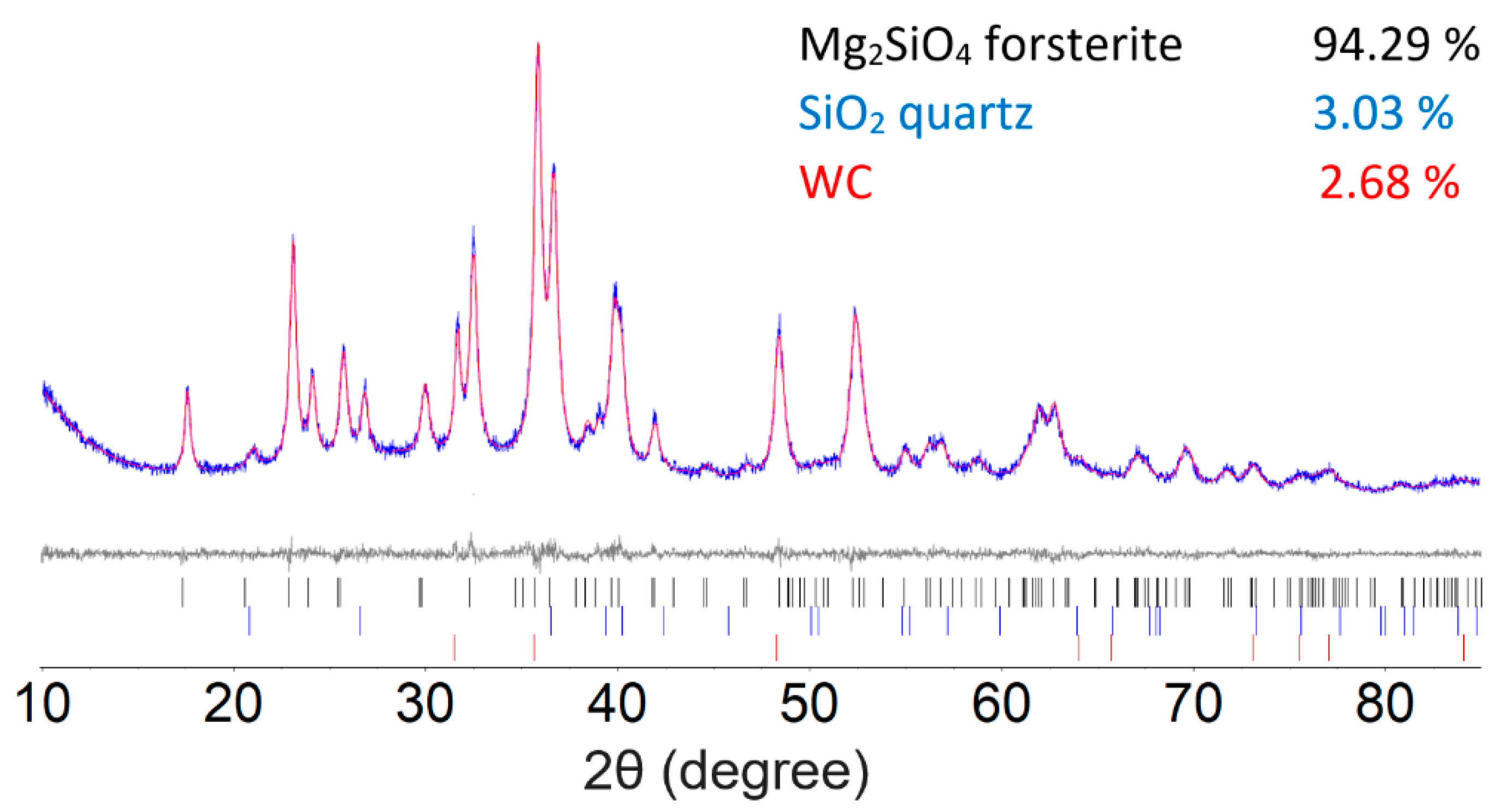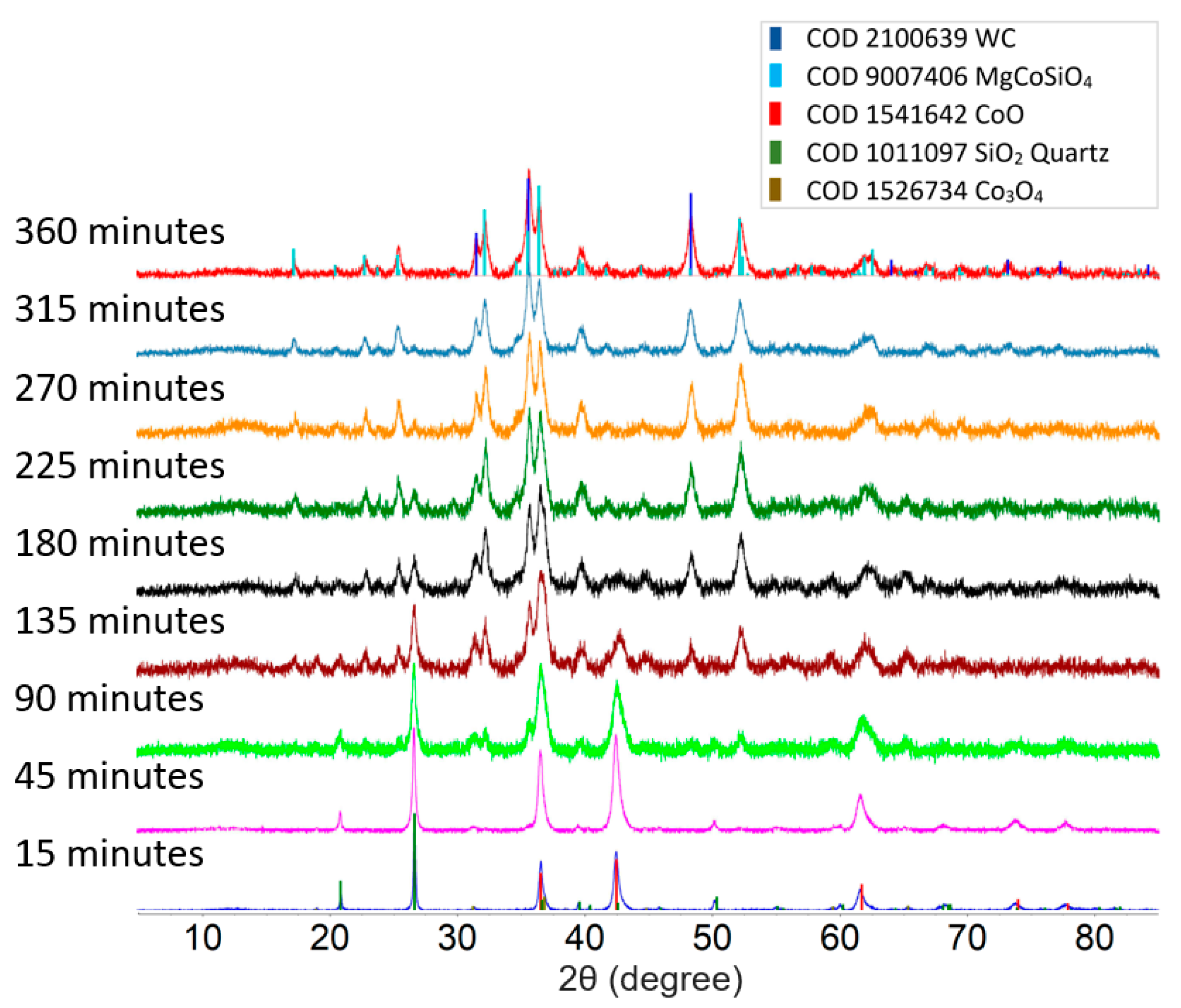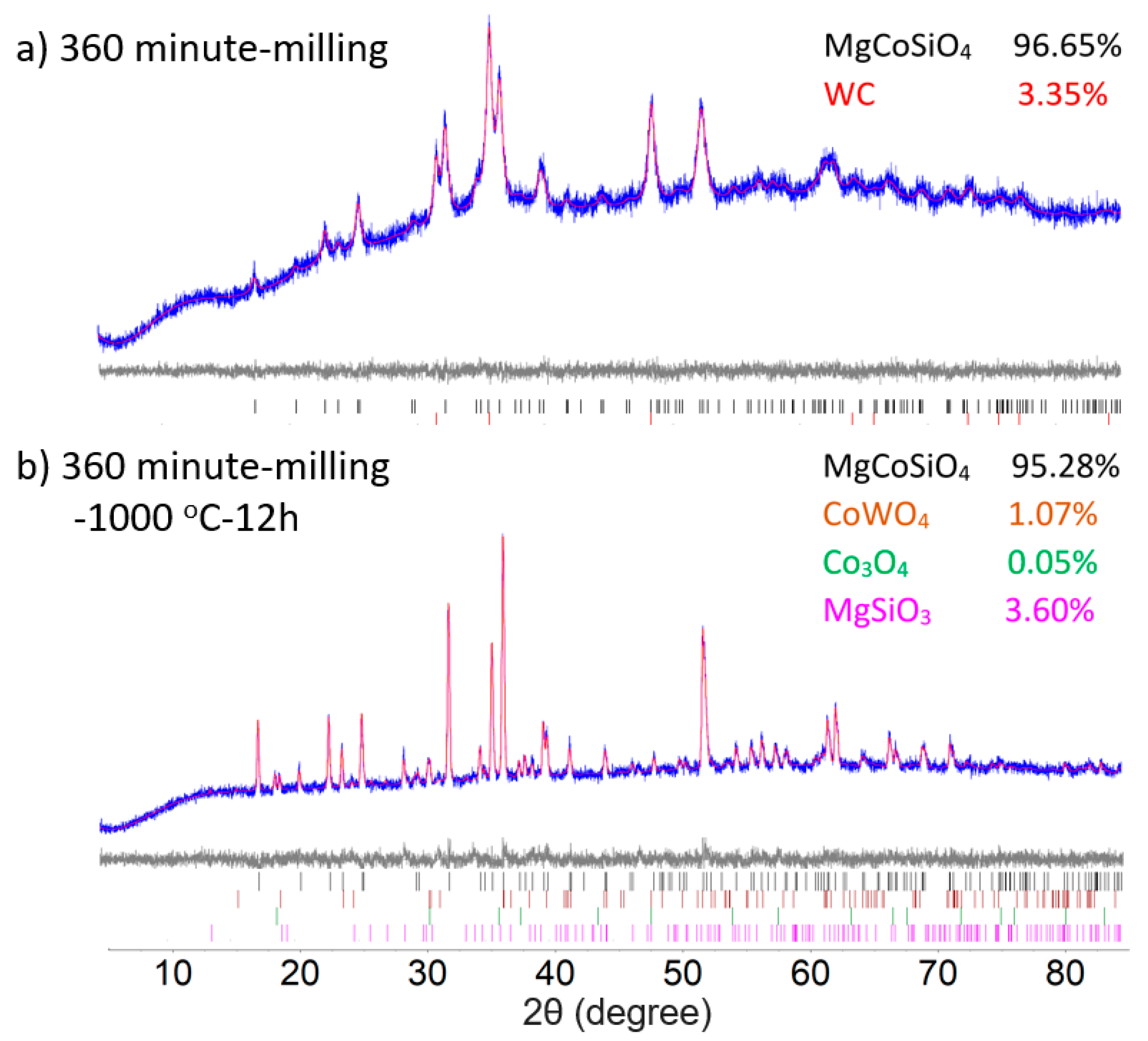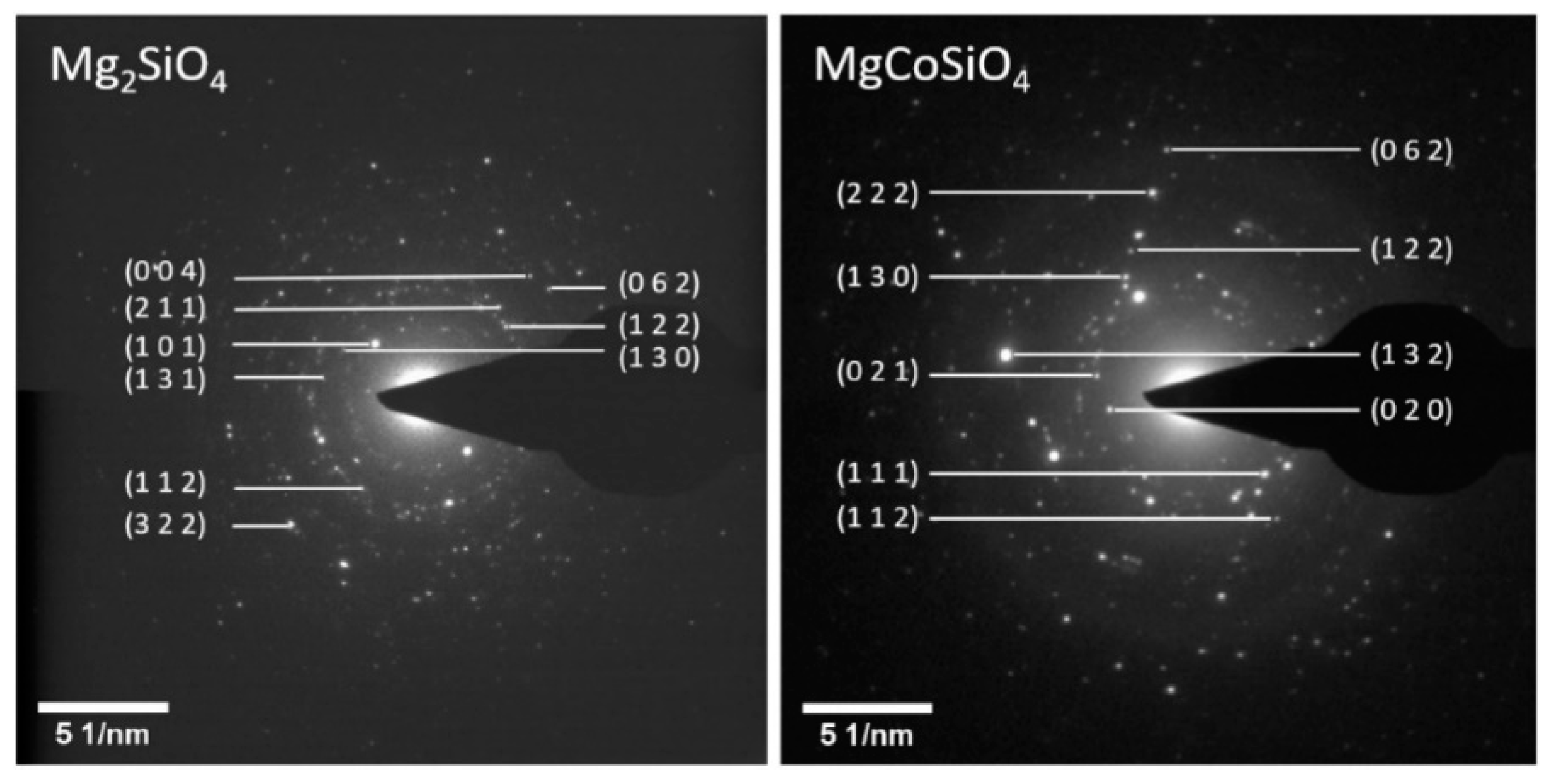Mechanochemical Synthesis of Nanocrystalline Olivine-Type Mg2SiO4 and MgCoSiO4
Abstract
:1. Introduction
2. Experimental Methods
3. Results and Discussion
4. Conclusions
Supplementary Materials
Author Contributions
Funding
Institutional Review Board Statement
Informed Consent Statement
Data Availability Statement
Acknowledgments
Conflicts of Interest
References
- Anderson, D.L.; Bass, J.D. Mineralogy and composition of the upper mantle. Geophys. Res. Lett. 1984, 11, 637–640. [Google Scholar] [CrossRef] [Green Version]
- McDonough, W.F.; Rudnick, R.L. Minerology and composition of the upper mantle. Rev. Mineral. 1998, 37, 139–164. [Google Scholar]
- Rudnick, R.L.; Fountain, D.M. Nature and composition of the continental crust: A lower crustal perspective. Rev. Geophys. 1995, 33, 267–309. [Google Scholar] [CrossRef] [Green Version]
- Volkov, N.V.; Mikhashenok, N.V.; Sablina, K.A.; Bayukov, O.A.; Gorev, M.V.; Balaev, A.D.; Pankrats, A.I.; Tugarinov, V.I.; Velikanov, D.A.; Molokeev, M.S.; et al. Magnetic phase diagram of the olivine-type Mg2GeO4 single crystal estimated from magnetic, resonance and thermodynamic properties. J. Phys. Condens. Matter 2013, 25, 136003. [Google Scholar] [CrossRef]
- Masquelier, C.; Croguennec, L. Polyanionic (phosphates, silicates, sulfates) framework as electrode materials for rechargable Li (or Na) batteries. Chem. Rev. 2013, 113, 6552–6591. [Google Scholar] [CrossRef]
- Ericsson, T.; Amcoff, O.; Kalinowski, M. Cation preferences in thio-olivines (Fe1−xMgx)2SiS4, x =< 0.30, studied by Mossbauer spectroscopy at room temperature. Neues Jb. f. Mineral. Mh. 1999, 11, 518–528. [Google Scholar]
- Chung, J.-H.; Ohgushi, K.; Ueda, Y. Magnetic phase diagram of the multicritical olivine Mn2SiS4 and Mn2GeS4. J. Magn. Magn. Mater. 2010, 322, 832–837. [Google Scholar] [CrossRef]
- Goldschmidt, V. Olivine and forsterite refractories in Europe. Ind. Eng. Chem. 1938, 30, 32–34. [Google Scholar] [CrossRef]
- Pack, A.; Hoernes, S.; Walther, T.; Bross, R. Behavior of basic refractories at high temperatures in steelmaking processes—thermodynamics and implications for the usability of olivine as refractory material. Eur. J. Mineral. 2003, 15, 193–205. [Google Scholar] [CrossRef]
- Routschka, G. Refractory Materials: Pocket Manual; Design, Properties, Testing; Vulkan-Verlag GmbH: Essen, Germany, 2008. [Google Scholar]
- Guo, H.; Ping, H.; Hu, J.; Song, X.; Zheng, J.; Pan, F. Controllable synthesis of LiFePO4 in different polymorphs and study of the reaction mechanism. J. Mater. Chem. A 2017, 5, 14294–14300. [Google Scholar] [CrossRef]
- Montserrat, F.; Renforth, P.; Hartmann, J.; Leermakers, M.; Knops, P.; Meysman, F.J. Olivine dissolution in seawater: Implications for CO2 sequestration through enhanced weathering in coastal environments. Environ. Sci. Technol. 2017, 51, 3960–3972. [Google Scholar] [CrossRef] [Green Version]
- Katsura, T.; Ito, E. The system Mg2SiO4-Fe2SiO4 at high pressures and temperatures: Precise determination of stabilities of olivine, modified spinel, and spinel. J. Geophys. Res. Solid Earth 1989, 94, 15663–15670. [Google Scholar] [CrossRef]
- Morioka, M. Cation diffusion in olivine—I. Cobalt and magnesium. Geochim. Cosmochim. Acta 1980, 44, 759–762. [Google Scholar] [CrossRef]
- Chakraborty, S. Diffusion coefficients in olivine, wadsleyite and ringwoodite. Rev. Mineral. Geochem. 2010, 72, 603–639. [Google Scholar] [CrossRef]
- Ringwood, A. Olivine-spinel transformation in cobalt orthosilicate. Nature 1963, 198, 79–80. [Google Scholar] [CrossRef]
- Morimoto, N.; Tokonami, M.; Watanabe, M.; Koto, K. Crystal structures of three polymorphs of Co2SiO4. Am. Mineral. 1974, 59, 475–485. [Google Scholar]
- Feng, Z.; Yang, J.; NuLi, Y.; Wang, J.; Wang, X.; Wang, Z. Preparation and electrochemical study of a new magnesium intercalation material Mg1.03Mn0.97SiO4. Electrochem. Commun. 2008, 10, 1291–1294. [Google Scholar] [CrossRef]
- Li, Y.; Nuli, Y.; Yang, J.; Yilinuer, T.; Wang, J. MgFeSiO4 prepared via a molten salt method as a new cathode material for rechargable magnesium batteries. Chin. Sci. Bull. 2011, 56, 386–390. [Google Scholar] [CrossRef] [Green Version]
- NuLi, Y.; Zheng, Y.; Wang, Y.; Yang, J.; Wang, J. Electrochemical intercalation of Mg2+ in 3D hierarchically porous magnesium cobalt silicate and its application as an advanced cathode material in rechargable magnesium batteries. J. Mater. Chem. 2011, 21, 12437–12443. [Google Scholar] [CrossRef]
- Zheng, Y.; NuLi, Y.; Chen, Q.; Wang, Y.; Yang, J.; Wang, J. Magnesium cobalt silicate materials for reversible magnesium ion storage. Electrochim. Acta 2012, 66, 75–81. [Google Scholar] [CrossRef]
- Orikasa, Y.; Masese, T.; Koyama, Y.; Mori, T.; Hattori, M.; Yamamoto, K.; Okado, T.; Huang, Z.-D.; Minato, T.; Tassel, C. High energy density rechargable magnesium battery using earth-abundant and non-toxic elements. Sci. Rep. 2014, 4, 5622. [Google Scholar] [CrossRef] [PubMed] [Green Version]
- Qafoku, O.; Ilton, E.S.; Bowden, M.E.; Kovarik, L.; Zhang, X.; Kukkadapu, R.K.; Engelhard, M.H.; Thompson, C.J.; Schaef, H.T.; McGrail, B.P.; et al. Synthesis of nanometer-sized fayalite and magnesium-iron(II) mixture olivines. J. Colloid Interface Sci. 2018, 515, 129–138. [Google Scholar] [CrossRef] [PubMed]
- Mori, T.; Masese, T.; Orikasa, Y.; Huang, Z.-D.; Okado, T.; Kim, J.; Uchimoto, Y. Anti-site mixing governs the electrochemical performances of olivine-type MgMgSiO4 cathodes for rechargable magnesium batteries. Phys. Chem. Chem. Phys. 2016, 18, 13524–13529. [Google Scholar] [CrossRef] [PubMed]
- Šepelák, V.; Myndyk, M.; Fabián, M.; Da Silva, K.L.; Feldhoff, A.; Menzel, D.; Ghafari, M.; Hahn, H.; Heitjans, P.; Becker, K.D. Mechanosynthesis of nanocrystalline fayalite, Fe2SiO4. Chem. Commun. 2012, 48, 11121–11123. [Google Scholar] [CrossRef] [PubMed] [Green Version]
- Nguyen, P.Q.H.; Zhang, D.; Rapp, R.; Bradley, J.P.; Dera, P. Room temperature facile synthesis of olivine-Co2SiO4 nanoparticles utilizing a mechanochemical method. RSC Adv. 2021, 11, 20687–20690. [Google Scholar] [CrossRef]
- Coelho, A.A. TOPAS and TOPAS-Academic: An optimization program integrating computer algebra and crystallographic objects written in C++. J. Appl. Crystallogr. 2018, 51, 210–218. [Google Scholar] [CrossRef] [Green Version]
- Gates-Rector, S.; Blanton, T. The powder diffraction file: A quality materials characterization database. Powder Diffr. 2019, 34, 352–360. [Google Scholar] [CrossRef] [Green Version]
- Schmidt, R.; Scholze, H.M.; Stolle, A. Temperature progression in a mixer ball mill. Int. J. Ind. Chem. 2016, 7, 181–186. [Google Scholar] [CrossRef] [Green Version]
- Takacs, L.; McHenry, J. Temperature of the milling balls in a shaker and planetary mills. J. Mater. Sci. 2006, 41, 5246–5249. [Google Scholar] [CrossRef]
- Matsui, Y.; Syono, Y. Unit cell dimensions of some synthetic olivine group solid solutions. Geochem. J. 1968, 2, 51–59. [Google Scholar] [CrossRef]
- Akimoto, S.I.; Fujisawa, H. Olivine-spinel solid solution equilibria in the system Mg2SiO4-Fe2SiO4. J. Geophys. Res. 1968, 73, 1467–1479. [Google Scholar] [CrossRef]
- Rinaldi, R.; Gatta, G.; Artioli, G.; Knight, K.; Geiger, C. Crystal chemistry, cation ordering and thermoelastic behaviour of CoMgSiO4 olivine at high temperatue as studied by in situ neutron powder diffraction. Phys. Chem. Miner. 2005, 32, 655–664. [Google Scholar] [CrossRef]
- Miyake, M.; Nakamura, H.; Kojima, H.; Marumo, F. Cation ordering in Co-Mg olivine solid-solution series. Am. Mineral. 1987, 72, 594–598. [Google Scholar]
- Müller-Sommer, M.; Hock, R.; Kirfel, A. Rietveld refinement study of the cation distribution in (Co,Mg)-olivine solid solution. Phys. Chem. Miner. 1997, 24, 17–23. [Google Scholar] [CrossRef]
- Sohor, M.A.H.M.; Mustapha, M.; Mamat, O. The Effect of Milling Duration on Silicon Dioxide Characterization; MATEC Web of Conferences; EDP Sciences: Les Ulis, France, 2017; p. 03007. [Google Scholar]






| This Study | Literature | ||||||||
|---|---|---|---|---|---|---|---|---|---|
| Mg2SiO4 | MgCoSiO4 | Mg2SiO4 | Mg2SiO4 | MgCoSiO4 | MgCoSiO4 | MgCoSiO4 | Co2SiO4 | ||
| 360 min | 360 min | Milled-1000 °C | Matsui et al. 1400 °C [31] | Akimoto et al. 1700 °C [32] | Rinaldi et al. 1200 °C [33] | Miyake et al. 1500 °C [34] | Sommer et al. 1200 °C [35] | Morimoto et al. 1500 °C [17] | |
| a (Å) | 4.756 (6) | 4.77 (3) | 4.775 (2) | 4.7553 (6) | 4.756 (1) | 4.77572 (8) | 4.771 (1) | 4.7713 (1) | 4.782 (4) |
| b (Å) | 10.224 (12) | 10.26 (7) | 10.267 (5) | 10.1977 (14) | 10.197 (1) | 10.27159 (17) | 10.245 (1) | 10.2533 (2) | 10.302 (4) |
| c (Å) | 5.993 (7) | 5.99 (4) | 5.999 (3) | 5.9820 (7) | 5.982 (1) | 6.00235 (10) | 5.988 (1) | 5.9911 (2) | 6.003 (4) |
| V (Å3) | 291.4 (6) | 294 (3) | 294.1 (2) | 290.09 (11) | 290.1 | 294.441 (6) | 293.09 (3) | ||
| [Co_1] | 0 | 0.606 (17) | 0.637 (13) | 0.698 (9) | 0.675 (2) | 0.666 (2) | |||
| [Co_2] | 0 | 0.409 (11) | 0.325 (11) | 0.302 (9) | 0.278 (21) | 0.334 | |||
| Si-O (Å) | 1.639 (2) | 1.642 (5) | 1.6428 (1) | 1.638 | 1.627 | ||||
| * M-O (Å) | 2.115 (5) | 2.122 (1) | 2.1233 (1) | 2.113 | 2.134 | ||||
| Rwp | 6.525 | 2.219 | 2.906 | 2.131 | |||||
Publisher’s Note: MDPI stays neutral with regard to jurisdictional claims in published maps and institutional affiliations. |
© 2022 by the authors. Licensee MDPI, Basel, Switzerland. This article is an open access article distributed under the terms and conditions of the Creative Commons Attribution (CC BY) license (https://creativecommons.org/licenses/by/4.0/).
Share and Cite
Nguyen, P.Q.H.; McKenzie, W.; Zhang, D.; Xu, J.; Rapp, R.; Bradley, J.P.; Dera, P. Mechanochemical Synthesis of Nanocrystalline Olivine-Type Mg2SiO4 and MgCoSiO4. Crystals 2022, 12, 369. https://doi.org/10.3390/cryst12030369
Nguyen PQH, McKenzie W, Zhang D, Xu J, Rapp R, Bradley JP, Dera P. Mechanochemical Synthesis of Nanocrystalline Olivine-Type Mg2SiO4 and MgCoSiO4. Crystals. 2022; 12(3):369. https://doi.org/10.3390/cryst12030369
Chicago/Turabian StyleNguyen, Phuong Q. H., Warren McKenzie, Dongzhou Zhang, Jingui Xu, Robert Rapp, John P. Bradley, and Przemyslaw Dera. 2022. "Mechanochemical Synthesis of Nanocrystalline Olivine-Type Mg2SiO4 and MgCoSiO4" Crystals 12, no. 3: 369. https://doi.org/10.3390/cryst12030369
APA StyleNguyen, P. Q. H., McKenzie, W., Zhang, D., Xu, J., Rapp, R., Bradley, J. P., & Dera, P. (2022). Mechanochemical Synthesis of Nanocrystalline Olivine-Type Mg2SiO4 and MgCoSiO4. Crystals, 12(3), 369. https://doi.org/10.3390/cryst12030369






